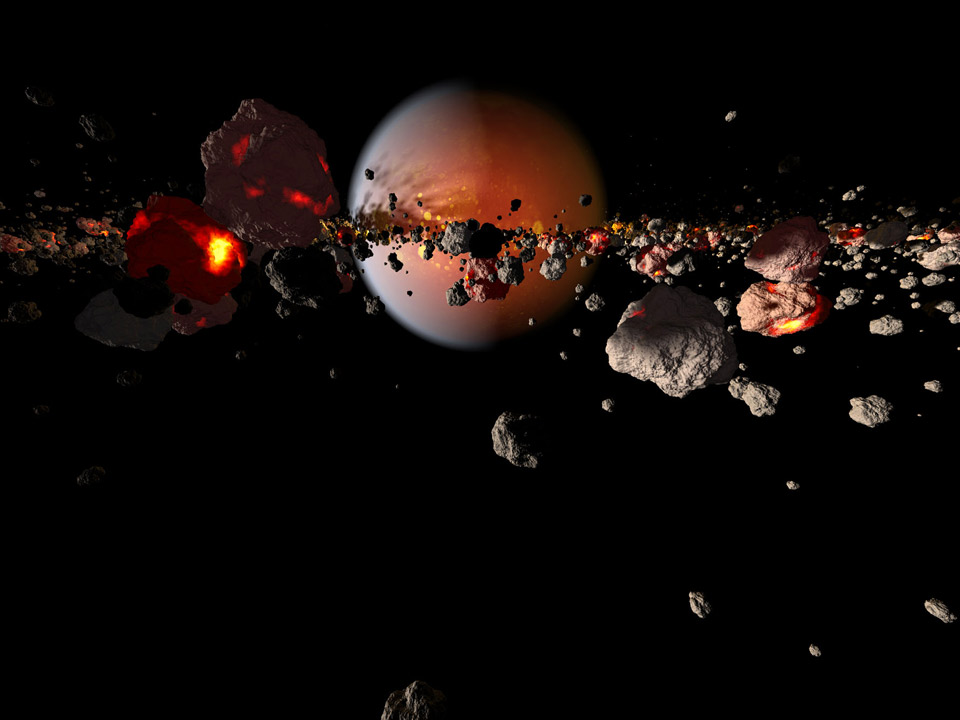
The moon, that giant lump of rock that has fascinated poets and scientists alike, may be about to get even more interesting. A new analysis of isotopes found in lunar minerals challenges the prevailing view of how Earth's nearest neighbor formed.
Most scientists believe Earth collided with a hypothetical, Mars-sized planet called Theia early in its existence, and the resulting smash-up produced a disc of magma orbiting our planet that later coalesced to form the moon. This is called the giant impact hypothesis. Computer models indicate that, for the collision to remain consistent with the laws of physics, at least 40% of the magma would have had to come from Theia.
One way to test the hypothesis is to look at the isotopes of particular elements in rocks returned from the moon. Atoms of most elements can occur in slightly different forms, called isotopes, with slightly different masses. Oxygen, for example, has three isotopes: 16O, 17O and 18O, indicating differences in the number of neutrons each nucleus contains. Compare any two samples of oxygen found on Earth and you'll find the proportions of 16O, 17O and 18O isotopes are almost identical in the two samples. The proportions found in samples from meteorites and other planets like Mars, however, are usually different. So if you find that a sample has the same oxygen isotope composition as one from Earth, then it's very likely the sample came from our world.
Previous research has established that the oxygen isotope composition of lunar samples is indistinguishable from that of Earth. Since 40% of the moon is supposed to have come from Theia (which presumably would have had a different isotope composition), this might spell trouble for the giant impact hypothesis. But it's possible that Earth may have exchanged oxygen gas with the magma disk that later formed the Moon shortly after the collision, explaining why the results are the same.
In the new research, published online today in Nature Geoscience, geochemists led by Junjun Zhang at the University of Chicago in Illinois, together with a colleague at the University of Bern in Switzerland, looked at titanium isotopes in 24 separate samples of lunar rock and soil. The proportion of 50Ti to 47Ti is another good indicator of whether a sample came from Earth, and, just as with oxygen, the researchers found the moon's proportion was effectively the same as Earth's and different from elsewhere in the solar system. Zhang explains that it's unlikely Earth could have exchanged titanium gas with the magma disk because titanium has a very high boiling point. "The oxygen isotopic composition would be very easily homogenized because oxygen is much more volatile, but we would expect homogenizing titanium to be very difficult."
So, if the giant impact hypothesis doesn't explain the moon, how did it get there? One possibility is that a glancing blow from a passing body left Earth spinning so rapidly that it threw some of itself off into space like a shot put, forming the disk that coalesced into the moon. This would explain why the moon seems to be made entirely of Earth material. But there are problems with this model, too, such as the difficulty of explaining where all the extra angular momentum went after the moon formed, and the researchers aren't claiming to have refuted the giant impact hypothesis.
Planetologist Matthias Meier of Lund University in Sweden, who was not involved in the new study, finds the research persuasive, but he's not ready to give up on the giant impact hypothesis either. "I think the general idea of having an impact forming a disk and this disk then forming a moon is probably right," he says, "but this paper shows us that we still don't understand exactly what the mechanism is, and there is a lot of work to be done in that field."



Maybe they are just chasing their tail because what they are studying, aren't lunar rocks!